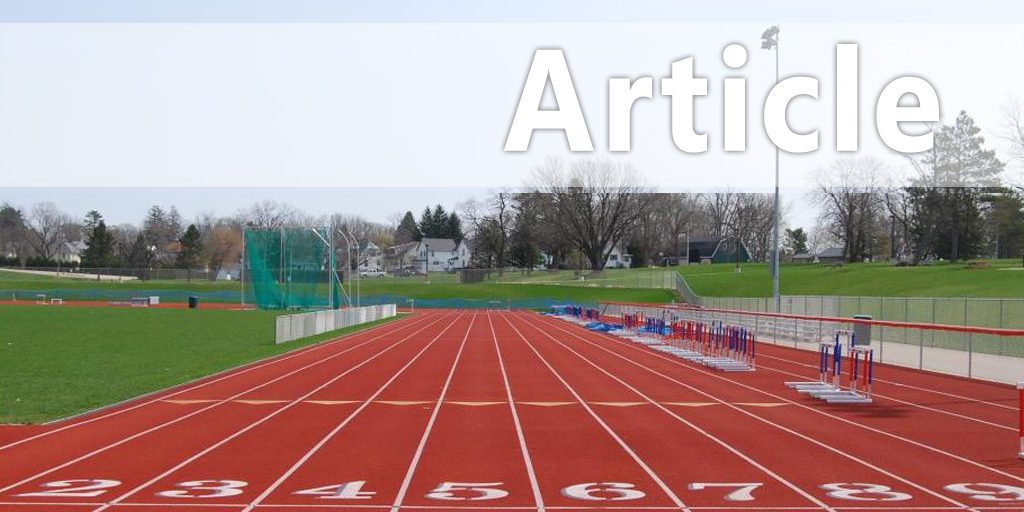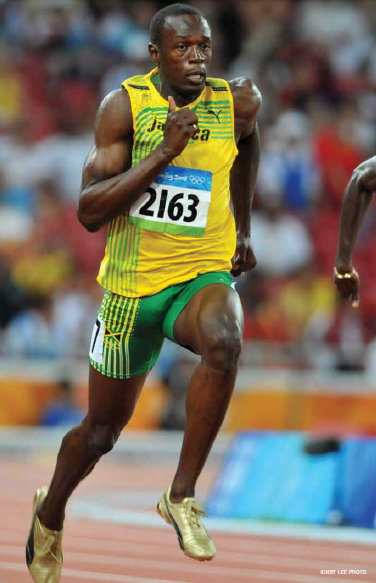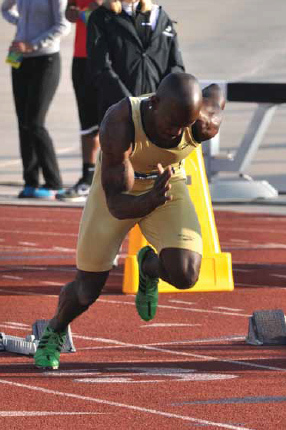| Acceleration Mechanics, Drills, Synthesis
Originally Published in: Techniques Magazine - USTFCCCA
GENERAL CONSIDERATIONS: As we begin to look at the body positions required to achieve proper sprint mechanics, there are some general considerations to consider at any level. Feet should be staggered 6-12 inches apart. Weight should be centered on the front foot. Knees are fixed, and the shin angles are acute. Shins should be parallel or near parallel to one another. Hips should be higher than the shoulders, and the head and neck should always be in a neutral position relative to the spine. These standards are non-negotiable. There are no stylistic differences when posture is being considered. We should always be cognizant of the fact that accelerative posture establishes posture for the remainder of the run. GETTING IN POSITION TO PUSH: BLOCK POSITION Blocks starts are often difficult to accomplish properly. It is an area that requires high power output levels to execute efficiently. Proper positioning in the blocks allows the sprinter a greater chance to achieve successful postural positions. Positioning the sprinter in the blocks requires some coaching expertise. The stronger leg (usually the left for a right handed runner) would be fitted to the front block, the smart (or quicker) leg fits in the back block. Individuals with lower power components are often more difficult to assess. The blocks are then set two feet (from the start line) to the front block and three feet to the back. Using a tape measure, this same distance can be determined by measuring .55 of the leg length to the front block, .42 to the back block. Again, these are general rules, and may have to be adapted to the individual. Once measured, the athlete then follows a standard protocol to enter the blocks, always backing into the blocks front to back. The feet are pressed firmly against the blocks with toes on the track, the athlete kneeling on rear knee only. Arms are placed firmly on the track, arms perpendicular to the track, thumbs under the shoulders. The hands form a bridge, maximizing the distance of the shoulders off the track. The head and neck should be in a neutral position relative to the spine. The front knee should be in line with the elbow, the back knee positioned 3-5 inches in front of the front foot. Taller and longer-legged athletes may need to fine-tune their position for optimal effect. THE SET POSITION: GOOD ANGLES MAKE A DIFFERENCE As the athlete rises into the set position, angles become extremely important to the future success of the start. Proper force production is established through the angles represented in the set position. As the athlete pushes on the pedals through the angle of the shin, the pedals will push back on the athlete with an equal and opposite force at the angle at which it was produced. In reaching the top of the set position, the athlete's hips will be raised slightly higher than the head. The front leg is set at approximately 90 degrees. The rear leg is flexed at approximately 130 degrees. The athlete should be focused on a motor task, not opponents, the starter's pistol, fans or anything other than the motor task previously established. Shins should be parallel to each other. The front shin determines the 45 degree angle to the track required. Shoulders will remain directly above the hands, with an emphasis on balance. Shoulders should not be past the hands, nor should the athlete be in a seated position with shoulders behind the hands either. Bodyweight should be evenly distributed between hands and feet. Hip-ankle relation must not be compromised. Full footed pressure on the blocks is preferred for the majority of athletes. THE START: INITIATING THE ACCELERATIVE PROCESS: The initial propulsion of the body down the track from the set position comes from the hips. The hips are the locomotive engine of the body and all force production is initiated form the hips and pelvic areas. As the start is initiated, the back foot pushes against the back pedal with great force. This is a common error in many starting techniques and is the cause of incomplete hip extension in most cases. As the back foot pushes hard against the back pedal, the front leg pushes through full extension. Because of the time required for the front foot to push and clear the front block, the arms must move with a powerful, aggressive action with large amplitude of movement. The head and neck continue to stay in a neutral alignment with the spine. The biggest coaching emphasis at this time should be placed on the displacement of the body. The entire body as a unit should be displacing at this time, with significant flight time a result of the large forces being applied to the blocks.
What are the most common errors occurring in the start. We have all seen on a practical basis commonalties occurring at the initiation of the sprint. The accelerative process can only be considered efficient if these common errors are corrected. When asked, most coaches can outline a series of common faults at the start. Most would say "stepping out," "popping up," lateral deviation in the preliminary step pattern, bending at the waist in an attempt to "stay low," and impatience in drive phase mechanics are the most common issues easily identified. All of these issues are directly caused by improper push mechanics at the start, whether it is due to improper angles and position in the set position or a power component incapable of achieving the positions required. So how do we repair these insufficiencies? Repetition of proper motor tasks and sequencing start mechanics from simple to complex are the two most obvious answers. Knowing the positions the athlete should be hitting prior to the start, during the initiation of the start and in the early stages of the drive phase goes a long way in affecting change. Stepping Out = This fault is a direct result of improper force production and incomplete push on the pedals. As the back foot pulls off the back pedal rather than push back on it, the from leg cannot reach the full extension required to put the athlete in the postural position desired at foot contact. To repair this problem, focus on full push on the back pedal and complete extension of the front leg. At the point of clearance, a first step contact point at an acute angle is then cued. If the base of support is not significantly behind the hips at this point, the athlete will not be able to produce the forces in the proper direction necessary for the remainder of the acceleration process. Popping Up = This fault is directly proportional to stepping out. As the athlete produces incomplete extension and pulls the back foot of the pedal without pushing, the stepping out effect that occurs causes the athlete to put his or her foot out in from of the hips. At that point, the foot contacts the ground vertically, or directly perpendicular to the track. This angle of contact can and will result in only one reaction, a return force directly vertically in the opposite direction which causes the body to stand up prematurely. To correct this issue, focus on the same solution as the one provided for stepping out. The athlete must achieve full extension and proper block clearance for an acute foot contact to occur on the first step out of the blocks. Lateral Deviation = As a general rule, this fault occurs when the athlete does not fully push off the back block and then makes an attempt to "make up" for the incomplete push by staying on the front block longer and pushing at an angle instead of straight back. This results in the proceeding steps deviating side to side until at some point down the track the body adjusts. Once again, two full footed pushes and complete hip extension will assist in correcting this issue. Bending at the Waist = This particular fault normally occurs as an athlete attempts to achieve a coaching cue. "Staying low" is a common cue coaches give athletes at the start. Almost without exception, this results in an ineffectual and even damaging posture that severely impairs the sprinter from achieving optimal sprint posture later in the race. Eliminating this cue from a coach's vocabulary is the first step in correcting this error. Then, focusing on positive postural positioning, cuing correct pushing applications and keeping the focus on "pushing down to stand up" is the key to success. Impatience in Drive Mechanics = Sprinters are often impatient individuals. They want to get up and run. The drive phase requires patience. Constantly cuing "push, push, push" and focusing on big, longer amplitudes of movement at the start will eventually affect change in this area. SYNTHESIS The starting process is much more complex than it appears. Developmental synthesis in order to incorporate proper postural positions is a must. Two point starts are followed by rolling starts. Rolling starts are followed by crouch starts. Crouch starts are followed by three point. Three point starts lead to four point and then eventually to the blocks. Synthesis means that until one stage is mastered, it will be difficult to move to the next level of complexity. THE FINAL PRODUCT The distance achieved during acceleration depends on the level of the athlete. The duration of the accelerative process ranges between 4-6 seconds. The initial postural positions established at the start and in the initiation of the spring must be conserved throughout the acceleration phase. The head, neck, spine, and pelvis remain in the neutral position established in the set position. A misalignment of the pelvis will result in gross mechanical issues later on and will result in incorrect force applications during the sprint. Posture should be in a straight line from the head to the feet. Pushing mechanics established at block clearance must be conserved throughout the acceleration process. Processing the complex nature of start and acceleration mechanics is inherently difficult. The coach has a huge responsibility to put the athlete in the best possible position to succeed. In sprinting, this means the coach has a responsibility to ensure the athlete maintains proper posture at the beginning of the sprint to ensure a greater opportunity to reach maximum velocity mechanics in proper arrangement. Hopefully, this short guide can serve as a starting point for coaches to have a better feel for coaching start mechanics. Tommy Badon is the Head Track & Field Coach at Lafayette Christian Academy in Lafayette, Louisiana. He is a longtime instructor in the USTFCCCA Track & Field Academy Sprints/ Hurdles/Relays Specialist Certification Course.
|




 Postural issues dominate the mechanics of track and field. Conserving posture throughout a race or trial in a field event is a key to optimal performance in any event. Initial postural issues from the start will be carried throughout the extent of the effort. These postural considerations are established during the entire accelerative process. Therefore, acceleration mechanics should be paramount in the overall mechanical development of a track athlete. Because initial postural positions are established in this phase of the sprint, and are therefore conserved in the max velocity and maintenance phases of the sprint, it is inherent in our coaching philosophy to place a high degree of emphasis on this area. Start mechanics, drive phase positions, foot contacts and posture in the early phases of a sprint should be placed as a high priority as we plan our training modalities.
Postural issues dominate the mechanics of track and field. Conserving posture throughout a race or trial in a field event is a key to optimal performance in any event. Initial postural issues from the start will be carried throughout the extent of the effort. These postural considerations are established during the entire accelerative process. Therefore, acceleration mechanics should be paramount in the overall mechanical development of a track athlete. Because initial postural positions are established in this phase of the sprint, and are therefore conserved in the max velocity and maintenance phases of the sprint, it is inherent in our coaching philosophy to place a high degree of emphasis on this area. Start mechanics, drive phase positions, foot contacts and posture in the early phases of a sprint should be placed as a high priority as we plan our training modalities. COMMON CAUSE/CORRECTION SCENARIOS:
COMMON CAUSE/CORRECTION SCENARIOS:


